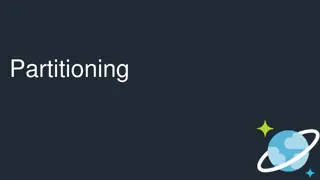Triangle Partitioning and Linear Optimization in Hockey Line Analysis
In this presentation, the speaker discusses the use of triangle partitioning and linear optimization techniques to analyze hockey team lines. The goal is to find chemistry between players, allocate ice time effectively, and match up against opposing lines for a better chance of winning games. Traditional methods like WoWY analysis are adapted for forward lines, and the concept of implicit WOWY stats triangle is introduced. By considering statistical measurements between players, the lines are partitioned into formations for strategic analysis.
Download Presentation

Please find below an Image/Link to download the presentation.
The content on the website is provided AS IS for your information and personal use only. It may not be sold, licensed, or shared on other websites without obtaining consent from the author. Download presentation by click this link. If you encounter any issues during the download, it is possible that the publisher has removed the file from their server.
E N D
Presentation Transcript
Triangle Partitioning and Linear Optimization of Forward Lines Chris Kang shinwook@uw.edu University of Washington NESSIS 2015
Motivation Objective of a coach is to win a hockey game by: 1. Finding chemistry between players 2. Finding balance among the lines (allocating appropriate Time on Ice) 3. Matching up against opposing lines Question: How can you analytically answer all these questions at once? Proposed Solution: A variation of team level With or Without You (WoWY) analysis (Triangle Partitioning)
Idea Traditional idea of finding chemistry between two players is to apply WoWY analysis Works well in the case of finding defensive pairs: Compare and contrast all possible defensive pairings 6 2 What about forward lines? We can try David Johnson s SuperWoWY* However, most teammates do not get to play on all possible lines, thus, sample size is too small for any analysis *www.puckanalytics.com
Triangle Partitioning Key Concept: Use implicit WoWY stats triangle of players Instead of looking for data where three players (3-tuple) are on the ice at the same time, use a chain of WoWY between two players Example: Line1 = {Sidney Crosby, Patric Hornqvist, David Perron} Crosby & Hornqvist - 54.9 CF% Crosby & Perron 58.8 CF% Hornqvist & Perron 56.8 CF% => Implicit CF% of Line1 - 56.83 CF%
Triangle Partitioning Generalization for all 4 Lines: Let V = {player1, player2, player3, .., player12} Then, E={e1,e2,e3, ., e } 12 2 where enis some statistical measurement between two players (i.e. CF%) 9 6 3 12 3 Then, consider all triangles. partitioning of the lines into 4 3 3 3
Triangle Partitioning Average Line Rank Gellability Player Average Rank 87 SIDNEY CROSBY 1.846753 57 DAVID PERRON 2.003247 26 DANIEL WINNIK 2.311688 17 BLAKE COMEAU 2.329221 19 BEAU BENNETT 2.41039 72 PATRIC HORNQVIST 2.45974 71 EVGENI MALKIN 2.462338 14 CHRIS KUNITZ 2.576623 13 NICK SPALING 2.677922 16 BRANDON SUTTER 2.733117 23 STEVE DOWNIE 2.894805 40 MAXIM LAPIERRE 3.292208
Application: Optimization With the implicit line data available for all possible configurations, we compute the optimal Time on Ice (TOI) to determine the best balanced lines. Linear Programming Setup: Maximize Team_CF% = t1L1+ t2L2+ t3L3+ t4L4 With Constraints: t1+ t2 + t3 + t4= 1 0 < t1 0 < t2 0 < t3 0 < t4
Distribution of Optimal Configuration
Distribution of Not-So-Optimal Configuration
Summary With the Triangle Partitioning idea, we can assess the chemistry of the entire lineup We can analyze the upper and the lower limit of a team CF% We can analyze the optimal allocation of Time on Ice for the 4 forward lines Brandon Sutter is not a good player
Thank You! Email: shinwook@uw.edu























